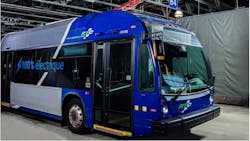Hitachi Energy deploys multi-vehicle electric bus charging solution for RTC in Quebec City
Hitachi Energy has deployed a centralized, multi-vehicle electric bus charging solution for Réseau de transport de la Capitale (RTC), the public transit agency in the greater Quebec City area. The technology was selected to be tested as part of a pilot project in 2022 following a call for tender won by Hitachi Energy. The three-year project represents an important step toward the ultimate electrification of the RTC’s entire bus fleet and infrastructure. The pilot is also providing valuable data on the best strategies for charging large numbers of vehicles.
The technology selected for the pilot is Hitachi Energy’s Grid-eMotion® Fleet solution, an integrated charging system that can deliver multi-megawatt level charging capabilities tailored to the demanding requirements of urban bus fleets. The system requires 60 percent less space than conventional charging systems and a 40 percent decrease in required depot cabling. The grid-to-plug solution has been deployed in sustainable transport projects at some of the biggest urban bus systems in the world, including London, Västerås, Sweden and Brisbane, Australia.
The project supports the Quebec provincial government's plan to electrify 55 percent of its urban buses and 65 percent of its school buses by 2030, a critical objective in Canada, where transportation accounts for about a quarter of total greenhouse gas emissions.
"Hitachi Energy is proud to support the RTC energy transition through our Grid-eMotion Fleet pilot deployment. This project offers a great opportunity to demonstrate how charging systems designed specifically for fleets can play a critical role in transitioning our urban transit systems to fully electric operations," said Hitachi Energy Managing Director, Grid Integration North America, Alireza Aram. "This exciting project is enabling us to explore different approaches to EV fleet charging in a real-world environment, gathering data that can be applied with public transit agencies around the world."
One of the key goals of the project is to explore different fleet charging strategies in an active bus terminal, including traditional plugs, as well as overhead pantograph systems. Typically, bus terminals in urban environments are space-constrained and were not designed for electric buses, which require compact, scalable and space-saving systems. Hitachi Energy’s Grid-eMotion Fleet technology can provide public transit agencies with much-needed flexibility to address the unique needs of each facility. Hitachi Energy’s solution has been tested at RTC’s Metrobus Center and is expected to run at full capacity in 2024.
